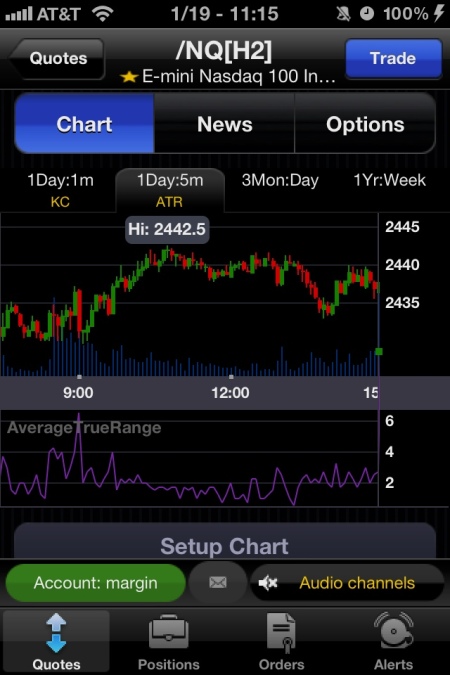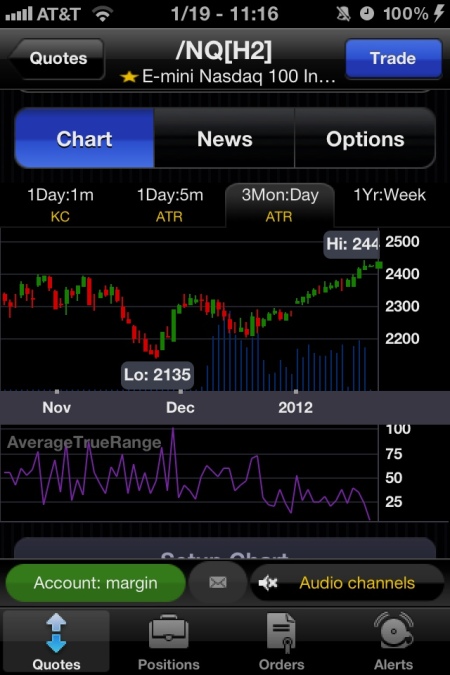In listening to the “Trading in the Zone” audiobook, I came to a section about truly thinking in probabilities and what it means to accept the risk of your trades. This got me thinking about a few things.
The basic facts are that we cannot know what will happen before we take any individual trade. There are too many unknowns and unknowables to have any certainty. We can have an edge that plays out over time, but in each individual trade literally anything can happen as any other traders enter or exit trades while we are in the market. It’s one thing to know that not every trade is a winner. It’s another thing to fully accept that before you put on a trade.
It occurred to me that the way I think about stop losses is wrong. Before I trade, I pick a stop point, usually by technicals, and how much money I’m “willing” to lose at most. This is not truly accepting that risk!! If the trade goes bad, I feel awful that I lost, that I was wrong, that my net wins/losses keep sinking. I feel like the market faded my decision and took away my money. Of course I don’t think the market is consciously trying to get me. I attribute it more to my own “bad” judgement. This also means that if a trade goes in my favor, I’m afraid of the market reversing and taking that little bit of profit and some capital away. I cut the winner. I also will bail out at break even if a trade fades a little, then goes back to my entry point. I feel lucky to “save” the money that was at risk. I cut myself off from the possibility that the trade might work out. I basically guarantee that I will either lose 1R, scratch or win much less than my usual 1R. Add in commissions and it’s a recipie for being a net loser.
Now sometimes, like in my last GSVC trade, I’ll manage the winner well. I did so because I had so much cushion from my entry point that I was no longer afraid of taking a loss. I hadn’t accepted the risk, I was just ignoring it because I had so much breathing room. If the trade had languished near my buy point, I’d probably have been looking for excuses to bail out near 16, if not for a small loss if it “looked” ominous.
It hit me that to really accept the risk of a trade, I need to think of the stop loss as the ante I need to pay to find out if the trade will work or not. Instead of defining it as a “worst case scenario that probably (in my head) won’t happen”, I need to think of it like the cost to buy a lotto ticket, or the chips required to pay the blinds in poker. Your stop loss and position size should represent the amount of money you are going to pay to see if this particular trade happens in the way that your edge predicts. As soon as you put on the trade, that money is spent. It’s gone. It’s not yours anymore. You don’t need to fear losing it any more than you fear losing the dollar you pay at a carnival to throw darts at balloons trying to win a prize. If you do fear that, you are trading too large. If you had to pay $1000 to throw that dart, you’d think twice. You’d measure the cost against what you might win. As a loser trader, you just put on any old trade and then hope it works out. That’s like paying the $1000 and then hoping you hit a balloon so you get the $1000 back to pay your rent, plus whatever extra winnings you get. You are going to make poor decisions, overpay for the chance to find out if you are right, and lose in the end.
I’m going to work on my personal thoughts about stop losses. I’m going to try to think of them not as a “worst case” possibility, but a certain cost. If I’m not willing to outright pay that certain cost for my potential trade, then I have no business taking that trade. A trader’s job is to judge opportunities, and unless you accurately judge the costs of testing your judgement, you’re sunk.
Ante up or fold!


